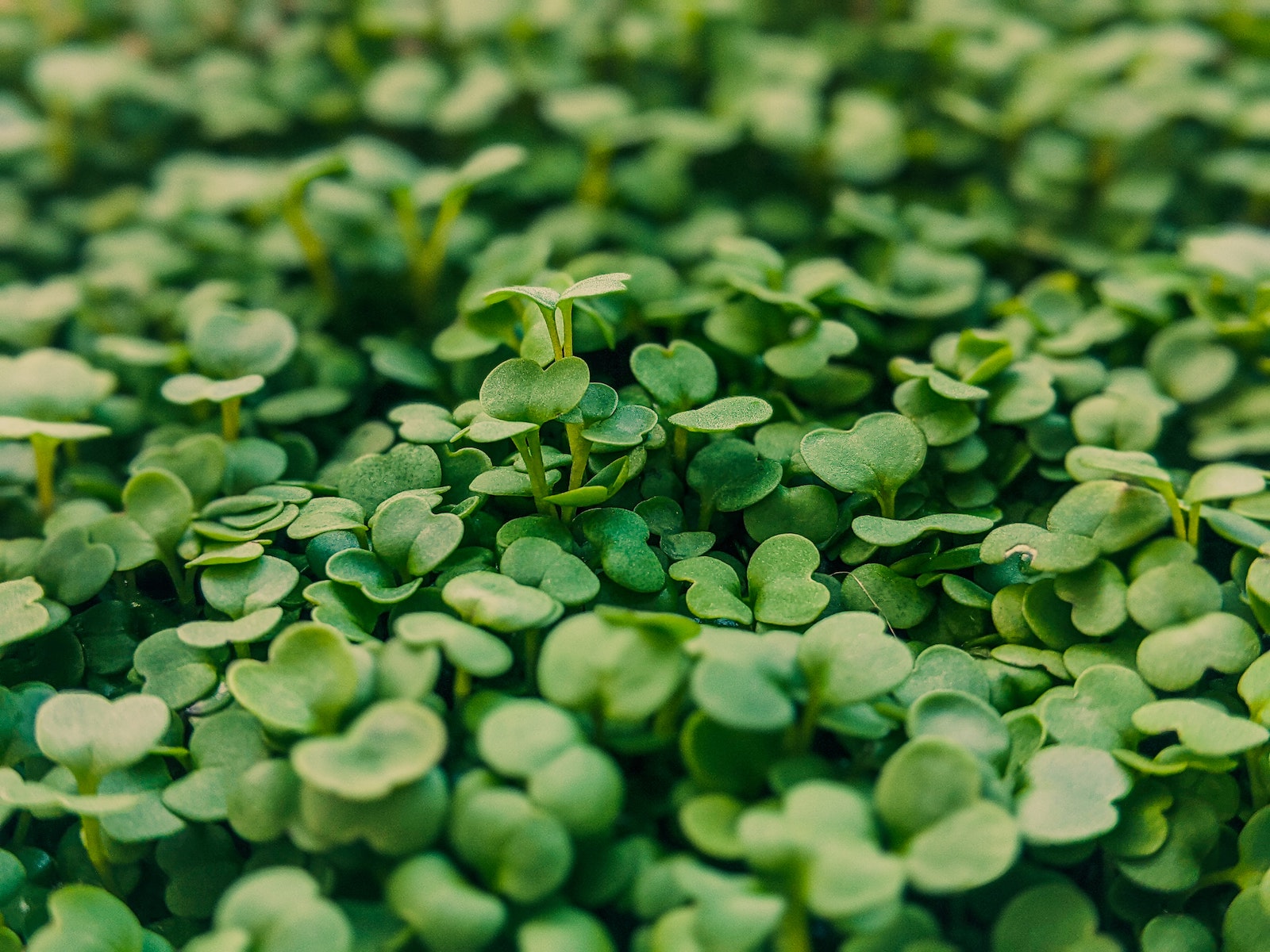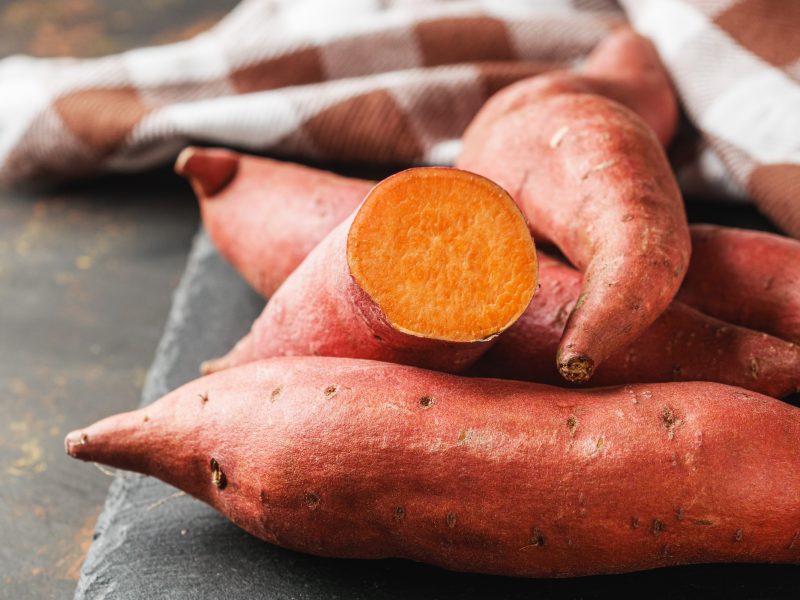You may have noticed these tiny leaves garnishing your meal, or dressing up a salad, but what are microgreens exactly?
Microgreens aren’t actually a single plant. They can be grown from any young vegetable and herb and are harvested at the seedling stage when they have only their seed leaves—before their true leaves have developed. Not to be confused with sprouts, which are germinated in water and harvested just as the seed begins to grow and before leaves develop. When the cotyledon (embryonic) leaves have fully developed and the first true leaves have emerged, the plant becomes a microgreen.
The most popular varieties are produced from these plant families:
- Brassicaceae: Cauliflower, broccoli, cabbage, watercress, arugula, and radish
- Asteraceae: Lettuce, endive, chicory, and radicchio
- Apiaceae: Dill, carrot, fennel, and celery
- Amaryllidaceae: Garlic, onion, and leek
- Amaranthaceae: Amaranth, quinoa, spinach, beet, and Swiss chard
- Cucurbitaceae: Melon, cucumber, and squash
Proponents of microgreens love them because they can be produced in a limited space and have a short growth cycle (usually 7-10 days). They use minimal external nutrients to grow, which means they have a low environmental impact, too.
The Health Benefits of Microgreens
Although microgreens are small in size, they provide surprisingly intense flavors, and they pack an outsized nutritional punch. A serving of microgreens is often a better source of vitamins and minerals than its mature counterpart. [1]
The exact breakdown of microgreens differs from one variety to another. [2] In fact, researchers from the U.S. Department of Agriculture found that after testing 25 different varieties of microgreens, ounce for ounce, options like red cabbage, amaranth, and cilantro can be more concentrated in important nutrients—including vitamin C, beta-carotene, and vitamin K—than their grown-up versions. [3]
Another study discovered that microgreens, including broccoli, can offer useful amounts of carotenoids and vitamin E, both of which act as antioxidants to help protect us against free radical cell damage. [4] In fact, the microgreen family Brassicaceae (primarily broccoli, daikon, and mustard) had the highest polyphenol, carotenoid, and chlorophyll contents, as well as incredibly high antioxidant power. [5]
Eating vegetables is linked to a lower risk of many diseases, likely due to the high amount of vitamins, minerals, and beneficial plant compounds they contain. Since microgreens contain similar—and often greater—amounts of these nutrients than mature greens, it’s thought that they may reduce the risk of the following diseases:
- Heart disease: Microgreens are a rich source of polyphenols, a type of antioxidant linked to a lower risk of heart disease. [6] One study also found that red cabbage microgreens lower levels of LDL (“bad”) cholesterol, liver cholesterol, and inflammatory cytokines, which are all factors that can increase your risk for heart disease. [7]
- Certain cancers: Antioxidant-rich fruits and vegetables, especially those rich in polyphenols, may lower the risk of various types of cancer. [8] Polyphenol-rich microgreens may be expected to have similar effects.
- Diabetes: Studies show that the consumption of leafy vegetables is associated with a reduction in Type 2 diabetes. [9] Plus, antioxidants may help reduce the type of stress that can prevent sugar from properly entering cells. In lab studies, fenugreek microgreens appeared to enhance cellular sugar uptake by 25-44%. [10]
- Gut health: Foods like microgreens that are high in dietary fiber can ease constipation or other gastrointestinal distress when eaten as part of a healthy, balanced diet. Research also indicates that dietary fiber serves as a prebiotic, [11] which allows the good bacteria in your microbiome to flourish.
How to Use Microgreens
Microgreens are a versatile accent to your food. They have flavors similar to the vegetables they’ll grow up to be, and they’re typically eaten raw because with their small size and high water content, cooking them isn’t recommended. Microgreens have a relatively mild but earthy flavor, so you can blend them in smoothies and use to season soups.
Add microgreens to sandwiches for a little flavor and crunch, mix them in your salad, or sprinkle on fish to take full advantage of their nutritional power. Once a relatively obscure green, you can now find them in grocery stores, farmers markets, and CSAs. And if you have a green thumb, you can easily grow them on your windowsill.
The Bottom Line
With microgreens becoming more available, it’s easier than ever to give these tiny vegetables a try. And because of their short growth cycle, it’s a food source that can be grown with minimal work. And while more research needs to be done into their health benefits, studies so far have indicated that microgreens are densely packed with nutrients.
While we aren’t suggesting you swap out your regular vegetables in favor of microgreens, you may want to start adding them to your diet, because they make a nutritious complement to the herbs and vegetables you’re already eating.
References
- Pinto E, Almeida AA, Aguiar AA, Ferreira IMPLVO. Comparison between the mineral profile and nitrate content of microgreens and mature lettuces. Journal of Food Composition and Analysis. 2015 Feb;37:38–43.
- Xiao Z, Lester GE, Luo Y, Wang Q. Assessment of vitamin and carotenoid concentrations of emerging food products: Edible microgreens. Journal of Agricultural and Food Chemistry. 2012 Jul 30;60(31):7644–51.
- Specialty Greens Pack a Nutritional Punch : USDA ARS [Internet]. www.ars.usda.gov.
- Paradiso VM, Castellino M, Renna M, Gattullo CE, Calasso M, Terzano R, et al. Nutritional characterization and shelf-life of packaged microgreens. Food & Function. 2018;9(11):5629–40.
- Marchioni I., Martinelli M., Ascrizzi R., Gabbrielli C., Flamini G., Pistelli L., Pistelli L. Small Functional Foods: Comparative Phytochemical and Nutritional Analyses of Five Microgreens of the Brassicaceae Family. Foods. 2021;10:427. doi: 10.3390/foods10020427
- Tangney CC, Rasmussen HE. Polyphenols, Inflammation, and Cardiovascular Disease. Current Atherosclerosis Reports [Internet]. 2013 Mar 20;15(5).
- Huang H, Jiang X, Xiao Z, Yu L, Pham Q, Sun J, et al. Red Cabbage Microgreens Lower Circulating Low-Density Lipoprotein (LDL), Liver Cholesterol, and Inflammatory Cytokines in Mice Fed a High-Fat Diet. Journal of Agricultural and Food Chemistry. 2016 Nov 28;64(48):9161–71.
- Zhou Y, Zheng J, Li Y, Xu DP, Li S, Chen YM, et al. Natural Polyphenols for Prevention and Treatment of Cancer. Nutrients [Internet]. 2016 Aug 22;8(8).
- Carter P, Gray LJ, Troughton J, Khunti K, Davies MJ. Fruit and vegetable intake and incidence of type 2 diabetes mellitus: systematic review and meta-analysis. BMJ [Internet]. 2010 Aug 19;341(aug18 4):c4229–9.
- Wadhawan S, Tripathi J, Gautam S. In vitro regulation of enzymatic release of glucose and its uptake by Fenugreek microgreen and Mint leaf extract. International Journal of Food Science & Technology. 2017 Sep 18;53(2):320–6.
- Holscher HD. Dietary Fiber and Prebiotics and the Gastrointestinal Microbiota. Gut Microbes. 2017 Feb 6;8(2):172–84.


